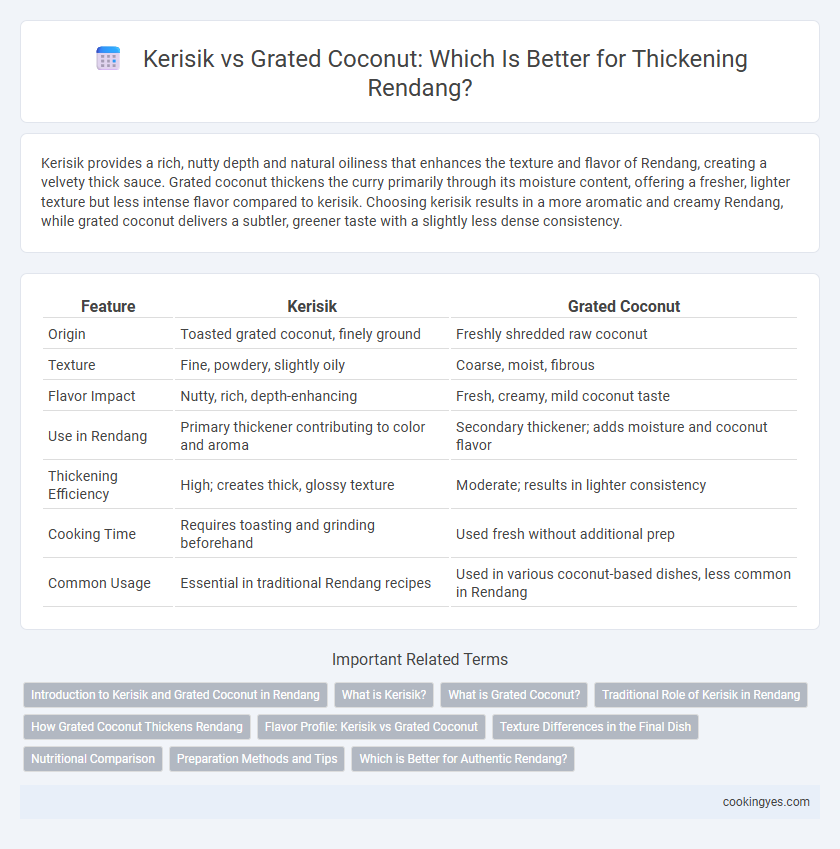Kerisik provides a rich, nutty depth and natural oiliness that enhances the texture and flavor of Rendang, creating a velvety thick sauce. Grated coconut thickens the curry primarily through its moisture content, offering a fresher, lighter texture but less intense flavor compared to kerisik. Choosing kerisik results in a more aromatic and creamy Rendang, while grated coconut delivers a subtler, greener taste with a slightly less dense consistency.
Table of Comparison
| Feature | Kerisik | Grated Coconut |
|---|---|---|
| Origin | Toasted grated coconut, finely ground | Freshly shredded raw coconut |
| Texture | Fine, powdery, slightly oily | Coarse, moist, fibrous |
| Flavor Impact | Nutty, rich, depth-enhancing | Fresh, creamy, mild coconut taste |
| Use in Rendang | Primary thickener contributing to color and aroma | Secondary thickener; adds moisture and coconut flavor |
| Thickening Efficiency | High; creates thick, glossy texture | Moderate; results in lighter consistency |
| Cooking Time | Requires toasting and grinding beforehand | Used fresh without additional prep |
| Common Usage | Essential in traditional Rendang recipes | Used in various coconut-based dishes, less common in Rendang |
Introduction to Kerisik and Grated Coconut in Rendang
Kerisik, a toasted and finely ground coconut paste, delivers a rich, nutty flavor and deepens the texture of rendang, distinguishing it from the milder, creamier consistency achieved with grated coconut. Grated coconut, when cooked down, contributes a slightly sweet and fresh coconut taste while serving as a natural thickening agent that maintains a lighter texture. Using kerisik intensifies the complexity and thickness of rendang, making it a preferred choice for authentic rendang recipes seeking a robust and aromatic profile.
What is Kerisik?
Kerisik is a toasted grated coconut paste commonly used in Rendang to impart a rich, nutty flavor and enhance the dish's texture. Unlike fresh grated coconut, kerisik undergoes a toasting process that deepens its aroma and adds a subtle caramelized sweetness, making it an essential thickening agent. Incorporating kerisik results in a thicker, more flavorful Rendang compared to using raw grated coconut alone.
What is Grated Coconut?
Grated coconut is freshly shredded white flesh of mature coconut, rich in natural oils and moisture, often used in Indonesian rendang to enhance texture and flavor. Unlike kerisik, which is toasted grated coconut ground into a paste, grated coconut provides a fresher, lighter consistency, contributing to a creamy yet slightly fibrous thickening agent. Its unroasted nature allows it to impart a milder coconut aroma while effectively absorbing the spices and coconut milk in the slow-cooked rendang.
Traditional Role of Kerisik in Rendang
Kerisik, a toasted grated coconut paste, plays a traditional and essential role in thickening Rendang while imparting a rich, nutty flavor that grated coconut alone cannot achieve. Unlike fresh grated coconut, which mainly adds moisture, kerisik undergoes a toasting process that enhances the depth and complexity of the dish's sauce. This careful preparation of kerisik contributes to the characteristic thick, velvety texture and aromatic profile central to authentic Rendang.
How Grated Coconut Thickens Rendang
Grated coconut thickens rendang by releasing natural oils and fibers when sauteed, creating a rich and creamy texture that enhances the dish's depth of flavor. The emulsification of coconut oil within the sauce helps to bind the liquid, resulting in a thicker, more luscious consistency. Unlike kerisik, which is toasted and ground, grated coconut provides a fresher, more fibrous base that contributes both body and subtle sweetness to rendang.
Flavor Profile: Kerisik vs Grated Coconut
Kerisik, a toasted coconut paste, imparts a rich, nutty, and slightly caramelized flavor to rendang, enhancing its depth and complexity. Grated coconut, when used fresh, provides a lighter, creamier texture with a subtle sweetness that intensifies the dish's natural coconut essence. The choice between kerisik and grated coconut directly influences the rendang's flavor profile, balancing between robust toasted notes and fresh coconut creaminess.
Texture Differences in the Final Dish
Kerisik, a toasted coconut paste, imparts a rich, nutty flavor and a smoother, more cohesive texture to rendang compared to grated coconut, which provides a coarser, chunkier mouthfeel. The toasting process of kerisik enhances its oil content, contributing to a thicker, creamier sauce that clings better to meat fibers. Using grated coconut results in a lighter, grainier consistency that may separate more easily during cooking.
Nutritional Comparison
Kerisik and grated coconut differ in nutritional content, impacting their use in thickening Rendang. Kerisik, produced by toasting grated coconut until golden brown, contains concentrated oils and antioxidants that enhance flavor while offering higher calorie density and healthy fats. Fresh grated coconut retains more moisture and fiber, providing a lighter texture with lower fat content and aiding digestion in the dish.
Preparation Methods and Tips
Using kerisik, which is toasted grated coconut ground into a smooth paste, adds a rich, nutty flavor and creamy texture to Rendang, enhancing its thickness naturally. Grated fresh coconut, when cooked down, provides a more fibrous consistency and requires longer simmering to achieve the desired thickness typical of authentic Rendang. For optimal results, toast fresh grated coconut evenly until golden brown before grinding into kerisik to maximize flavor infusion and achieve the ideal Rendang sauce consistency.
Which is Better for Authentic Rendang?
Kerisik, made from toasted grated coconut, provides a richer, nuttier flavor and a smoother texture, making it the preferred choice for authentic Rendang thickening. Grated coconut, while useful, lacks the depth and caramelized aroma essential to traditional Rendang dishes. Choosing kerisik enhances the dish's complexity and preserves the true essence of Indonesian Rendang.
Kerisik vs grated coconut for thickening Infographic

 cookingyes.com
cookingyes.com